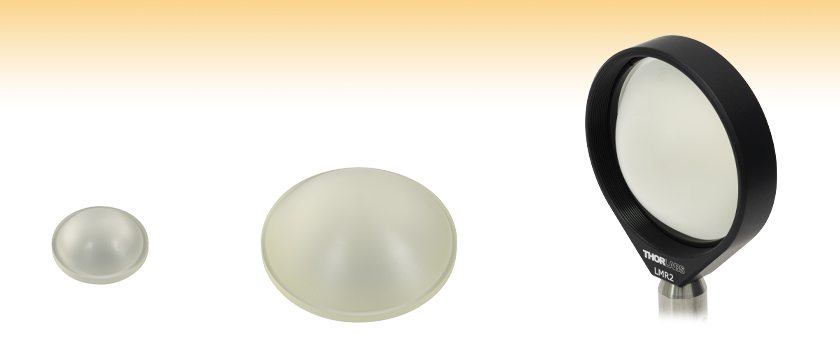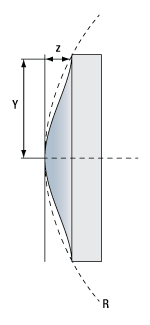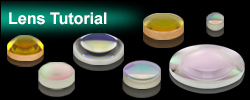TPX Plano-Convex Aspheric Terahertz Lenses

- High Transparency from 0.1 to 3 THz
- Available in Ø1", Ø50.0 mm, or Ø2"
- Back Focal Lengths from 15.0 to 100.0 mm
AL235
Ø50.0 mm TPX Lens for THz,
f = 35.0 mm, NA = 0.54
Application Idea
AL235 Mounted in an LMR2
AL115
Ø1" TPX Lens for THz,
f = 15.0 mm, NA = 0.59

Please Wait

Click to Enlarge
Figure 1.1 This graph compares the attenuation coefficients for TPX and PTFE materials as given by the Beer-Lambert law.
Features
- Material: TPX (Polymethylpentene)
- Ideal for Use from 0.1 to 3 THz
- Available Sizes: Ø1", Ø50.0 mm, and Ø2"
- Back Focal Lengths Available from 15.0 to 100.0 mm
These TPX (Polymethylpentene) Aspheric Lenses are optimized for focusing or collimating THz radiation from 0.1 to 3 THz. These lenses offer higher transmission in this frequency region compared to our PTFE lenses. Please see Figure 1.1 for a comparison of the attenuation coefficients of these materials. TPX aspheric lenses are ideal for use with THz emission from our PCA800 THz Antenna and offer easier alignment and improved beam quality compared to off-axis parabolic mirrors.
Please note that it is essential to match the NA of the lens used for collimation with that of the output radiation to avoid truncating the spectrum, because the frequency of the emission from a THz antenna is angularly dependent.
| Common Specifications | |
|---|---|
| Material | TPX (Polymethylpentene) |
| Index of Refraction | 1.45 at 1 THz |
| Shape | Plano-Convex (Aspheric) |

Click to Enlarge
Figure 2.1 Reference Drawing
Lens Design Formula
- Positive Radius Indicates that the Vertex is Located Left of the Center
- Negative Radius Indicates that the Vertex is Located Right of the Center
| Variable Definitions | |
|---|---|
| z | Sag (Surface Profile) as a Function of Y |
| Y | Radial Distance from Optical Axis |
| R | Radius of Curvature |
| k | Conic Constant |

The radius of curvature and conic constant for each lens are listed in Tables G1.1, G2.1, and G3.1 as well as in the individual lens drawings, which can be accessed by clicking the red docs icon (![]() ) next to each lens sold below.
) next to each lens sold below.
| Posted Comments: | |
Jelle Dean
(posted 2024-09-17 13:16:38.157) Hello, I'm interested in yours Plano-Convex Aspheric Terahertz Lenses, but I can't understand the way you defining BFL parameter. I'm really curious about the method you're using for calculating it. Is there an analytic equation or the presented BFLs are results of numerical/model simulation? jpolaris
(posted 2024-09-27 06:29:35.0) Thank you for contacting Thorlabs. The back focal length (BFL) is simply the distance from the rear surface of the lens (plano surface in the case of AL115) to the location of the tightest focus. This distance is verified through measurement, but it follows from Snell's law and the aspheric Sag (Z) equation. The index of the TPX substrate at 1 THz is 1.45. I have reached out to you directly to discuss further. |

| Table G1.1 Specifications | ||||||||
|---|---|---|---|---|---|---|---|---|
| Item #a | Diameter | Back Focal Length | Numerical Aperture | Center Thickness | Edge Thickness | Clear Aperture | Radius of Curvature (R)b | Conic Constant (k)b |
| AL115 | 1" | 15.0 mm | 0.59 | 10.0 mm | 2.5 mm | 22.4 mm | 9.9337 mm | -0.57635 |
| AL125 | 1" | 25.0 mm | 0.38 | 8.0 mm | 3.1 mm | 22.4 mm | 13.878 mm | -0.57699 |
| AL150 | 1" | 50.0 mm | 0.21 | 7.0 mm | 4.4 mm | 22.4 mm | 24.9368 mm | -0.59181 |

| Table G3.1 Specifications | ||||||||
|---|---|---|---|---|---|---|---|---|
| Item #a | Diameter | Back Focal Length | Numerical Aperture | Center Thickness | Edge Thickness | Clear Aperture | Radius of Curvature (R)b | Conic Constant (k)b |
| AL265 | 2" | 65.0 mm | 0.33 | 13.0 mm | 4.1 mm | 47.6 mm | 33.657 mm | -0.58018 |
| AL2100 | 2" | 100.0 mm | 0.23 | 10.0 mm | 4.0 mm | 47.7 mm | 48.6619 mm | -0.5766 |
 Products Home
Products Home






 Unmounted TPX THz Lenses
Unmounted TPX THz Lenses